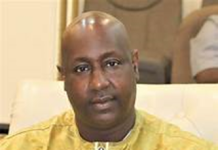With Madiba Singhateh
Part One
Welcome to another Edition of the Environment Column. In this week’s Edition of the Column, the Columnist caught up with the EBA Project Manager and adviser to the Environment Ministry Dr. Malanding Jaiteh, who spoke about the impact of climate and the restoration of EBA Project on the country’s forest cover. Here is some of the excerpts of their discussion.
Q. The Government of the Gambia through the Ministry of the Environment in partnership with the United Nations Environment Program (UNEP), secured funding from the Green Climate Fund (GCF) to implement a six year project large-scale Ecosystem-based Adaptation project(EBA) in the Gambia to develop a climate resilient and natural resource-based economy. Can you tell us why this climate resilience project is important to the country?
Dr. Jaiteh:- Well Climate change has been in the world for some time now but over the last thirty to forty years it has become very clear that human activity such as pollution and the emission of hazardous gases and chemicals, and land degradation for agriculture or industrialization, has resulted in increase temperature as a result of increase carbon dioxide in the atmosphere. However these emissions and their impact globally, differ from place to place. Here in the Gambia, one of the most evident impacts of climate change is the reduction in rainfall.
In the 60s, 70s and part of the 80s, rainfall begins in the Gambia from late May until October. But now we have seen a very significant shift of this during the rainy season which sometimes begin in July or even the end of July. And off course the amount of total rainfall across the country used to be more than 1,000 mm but now rainfall records for the whole rainy season fall way below 1,000 mm.
Scientist across the world have indicated that one of the ways to curb the impact of climate change is to plant more trees and change the land scape and reduce the extremely dry weather conditions. People have now gone into wetlands or forests areas in order to produce more food; that if we increase the forest cover, some of these ecosystems can recover to their natural state and changes in the imbalance of water will also improve. Temperatures will go down to a micro level as well.
So EBA as a project is conceived to revitalize these ecosystems that are mainly degraded in the Gambia and to improve their conditions so that those people whose livelihoods depend on cutting down trees can also improve, by growing crops and doing other activities that will not destroy the environment.
The EBA project came in with two basic components. One is the restoration of degraded ecosystems and the other component is to develop and promote natural resource base enterprises.
Q. The EBA project’s approach to natural resource management is cost effective and low-risk in building climate resilience of poor communities in the Lower River, Central River South, Central River North and Upper River Regions by improving on the rural landscapes and sustainable management of the Gambia’s natural resources in a commercial manner. Why is the project focused in those particular communities of the country?
Dr. Jaiteh:- The fact that we are not in the Western Region is to focus on areas that need this the most and its clear from the geography and climate records of the country that most of the areas we focus on now are the driest areas parts of the country. They areas have large concentrations of the country’s community forests. These areas where one time dense forest lands but communities claimed them and they were designed and Gazetted so that they can continue to remain as forest for use by the community.
So when the EBA project came, attention was to focus on these forests rather than everywhere. Much of what we do is within these community forests.
So the concentration of the project on community forests in CRR and URR is one reason why we are those communities and of course not forgetting the LRR where there are community base forests such as the Kiang West National Park and other community forests. These are all reasons why the EBA project focuses on these areas and the other reason is that these are deprived communities compared to the Western Region.
Q. The EBA project also has Policy support, institutional strengthening and knowledge generation to support the large-scale implementation of the project in the country such as environmental resource management of the Country’s flora and fauna. How are you working with policy makers to curb environmental degradation because it is noticeably on the rise?
Dr. Jaiteh:- Yes we recognized that ecosystems can be restored to start and implement enterprises. But this cannot be done in a vacuum. There needs to be some policy and strategy to replant the different dry and empty landscapes across the country. That is why we have this third component of working with all the relevant Government agencies to assist in integrating these ideas. We need to do more replanting in these dry landscapes and this should be incorporated into their policies. We have worked with the Forestry Department to assist in the establishment of the 2019 Forest Strategy Plan for instance and also with the Department of Parks and Wildlife in order to see the type of activity and policy they should adopt in order to enhance those areas under their jurisdiction. All of this is to make it easier to transform dry landscapes into farm lands and forest.
Q. The Gambia has been included in the International Panel on Climate Change’s (IPCC) critical list of 100 countries that are most vulnerable to climate change and also most at risk from its projected impacts.
What are the environmental mitigation action plans that the EBA project anticipates to change this?
Dr. Jaiteh:- Yes, again but when it comes to action against climate change, there are two levels. One is mitigation and the order is adaptation. Mitigation is often to reduce the impact but this goes to a point when you want to continue on the same trend and this is what adaptation is all about.
So what we need to do is to continue with the project by moving to the next level of adaptation. We have recognized from our own base line study that temperatures in this country will continue to rise in the next 50 years. There will hotter days and dryer rainy seasons with erratic rainfall. What this mean is there will less water for tree growth or even for consumption to sustain ourselves and our livelihoods.
This is the fundamental part of the EBA project to reduce or halt this phenomenon.
So, what we are doing now is what the scientist say recommend for countries to do. On the adaptation side of their recommendation, we have identified the tree species that have and can survive in hash climates. Most often, these are natural indigenous tree species that have been around and are still around.
We also take into consideration the value and benefit of these tree species for the people. In fact there is some history of agro-forestry in this country where trees are deliberately left on farmlands. We know such types of tree species that people keep on their farmlands.
When it comes to the public getting benefits out of these tree species, we have already identified thirty communities where we will provide bee hives and bee keeping materials. We are working with a national group that has experience in bee keeping so that they can assist those individual communities in the management of these hives including honey collection and processing to international standards. We have also engaged the Gambia Standards Bureau to assist in identifying the best way to produce Gambian honey for international markets. If we put more value and invest in it, people will start recognizing Gambian honey. This will add to its value and people in the international community will want to do business with the Gambia.
But of course, that cannot happen without having the right type of species of tree and protection of the forest from bushfires and illegal logging.
To be continued….




















